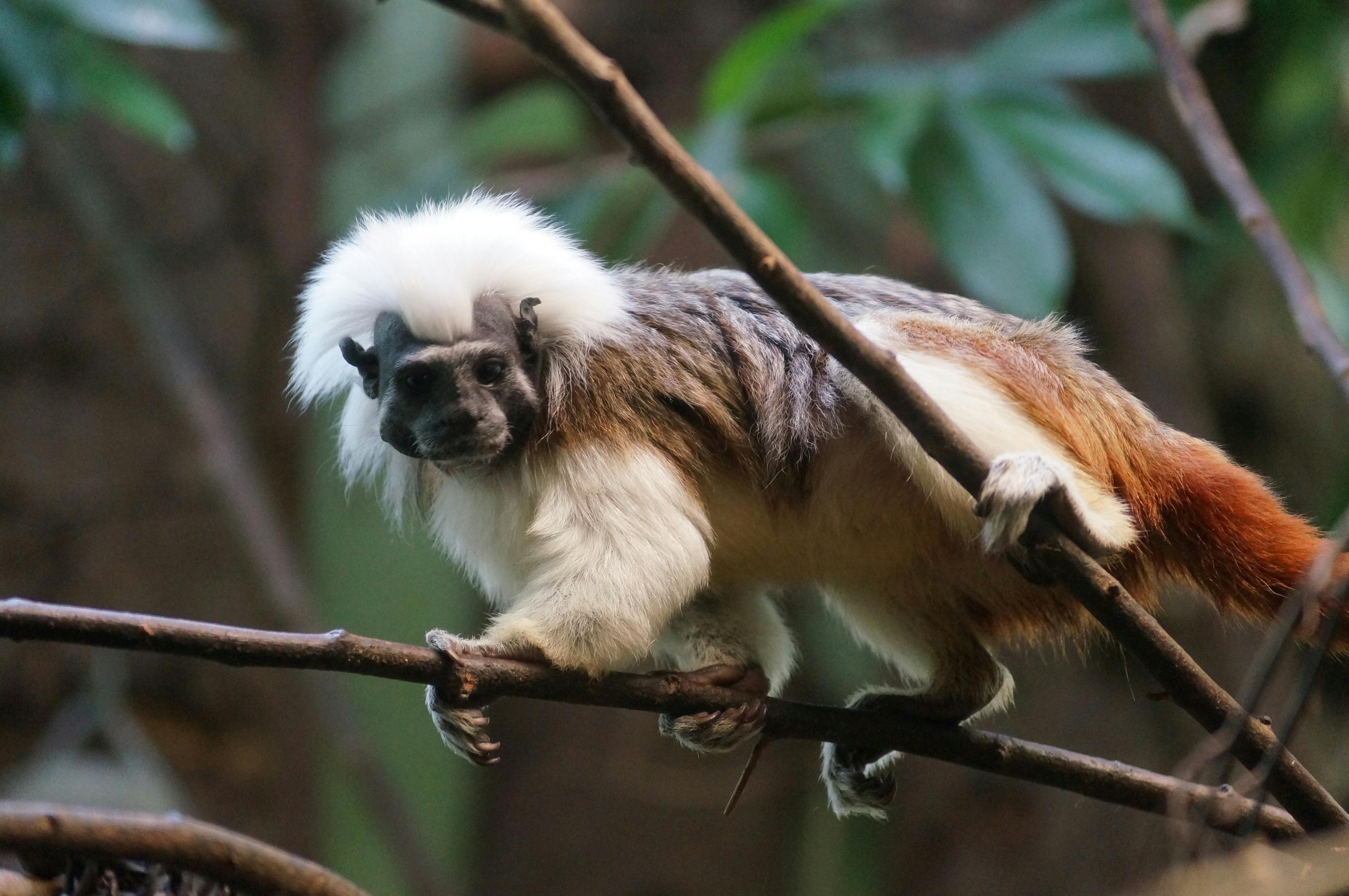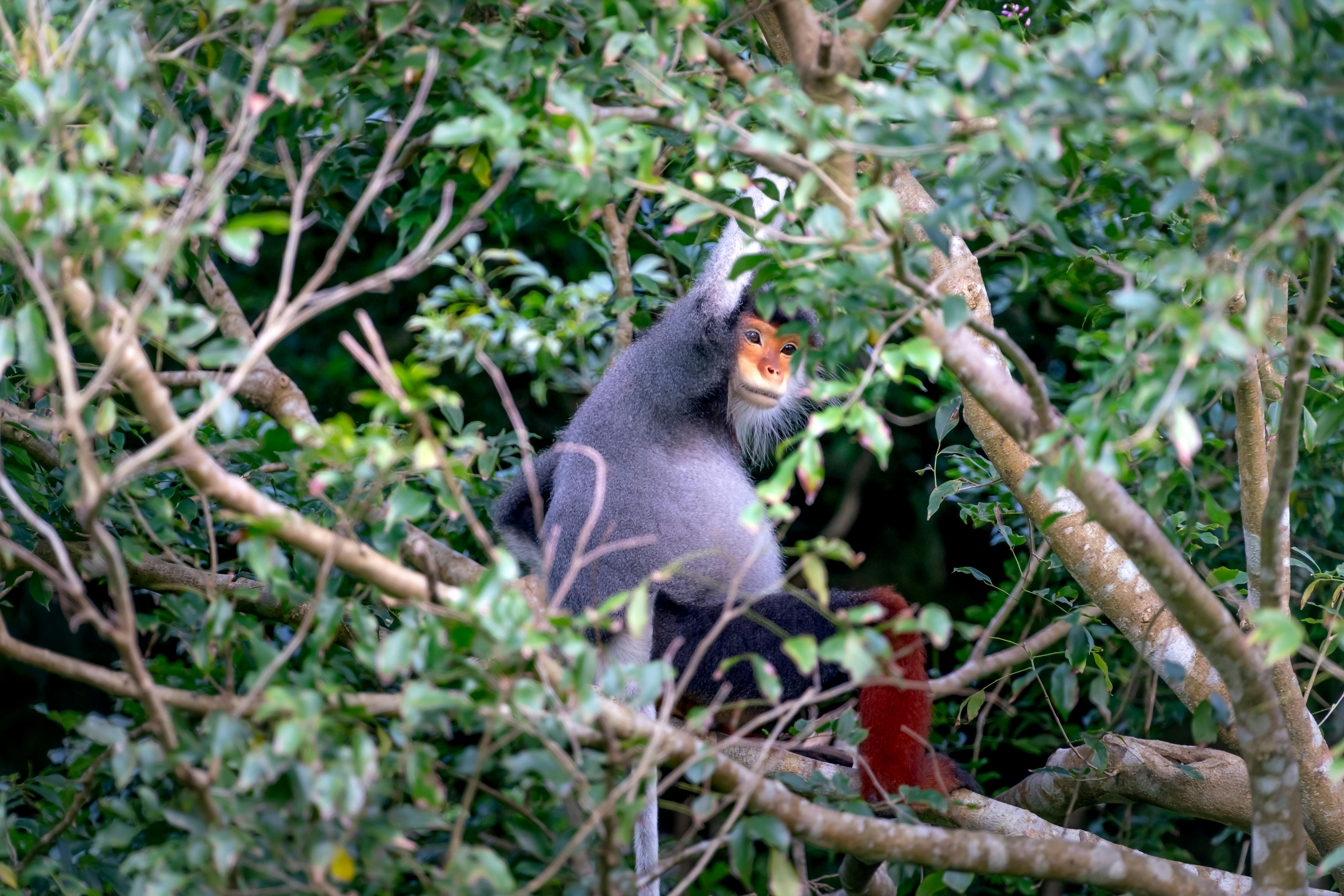The red-handed tamarin (Saguinus midas) is a small species of monkey native to the tropical rainforests of South America. This primate is easily recognizable by its distinctively colored hands and feet, which are bright reddish-orange in color. Red-handed tamarins are also known for their playful and social behavior, often forming large groups with up to 15 individuals. They are omnivorous, feeding mainly on fruits, insects, and other small invertebrates. These monkeys are considered a threatened species due to habitat destruction and poaching for the pet trade.A Red-Handed Tamarin is a small primate found in the Amazon rainforest. It is a type of marmoset that is distinguished by its black and white body, reddish-orange hands and feet, and long, black tail. It is an arboreal species that inhabits the canopy layer of the rainforest, where it feeds mainly on fruits, insects, and other small animals. This species is also known for its loud calls and cooperative breeding behavior.
Contents
Physical Characteristics
The Red-Handed Tamarin is a small, primates with a body length of around 15 to 16 cm and a tail length of around 25 to 30 cm. They have a black face and head with white tufts on their ears, while the rest of their body is covered in reddish-brown fur. The underside of their tail is white, and they have distinctive red hands and feet. They weigh between 300 and 500 grams, making them one of the smallest primates in the world.
Behavior
Red-Handed Tamarins are social animals, living in groups ranging from two to fifteen individuals. They are diurnal animals, meaning that they are most active during the day, though they may become active at night if disturbed. They are arboreal animals, spending most of their time in trees or other vegetation. Their diet consists mainly of fruit, insects, and nectar from flowers.
Habitat
Red-Handed Tamarins can be found in tropical areas throughout Central and South America, primarily in Brazil. They prefer dense rainforest areas with tall vegetation for them to climb on. They make their homes high up in trees or along tangled vines near rivers or streams where they can find food easily.
Reproduction
Red-Handed Tamarins typically give birth to one or two offspring at a time after a gestation period of 131 days. Both parents care for the young until they become independent at around three months old. The young will stay with the family group until they reach sexual maturity at around 18 months old.
The Diet of a Red-Handed Tamarin
The red-handed tamarin is an adorable small monkey that lives in the tropical rainforest of South America. As omnivores, their diet consists of a variety of fruits, insects, lizards, frogs, and small vertebrates. They are also known to eat sap from trees and nectar from flowers. This diet helps them to obtain the necessary nutrients for their small bodies.
In the wild, most of the red-handed tamarins’ diet is composed of fruit and insects. Fruits are an essential part of their diet as they provide essential vitamins and minerals that are not found in other food sources. Insects provide protein and fat which is necessary for energy. Lizards, frogs, and small vertebrates also make up a portion of their diet as these animals provide additional protein and fats that are not found in fruits or insects.
The red-handed tamarin is also known to eat sap from trees as well as nectar from flowers. Saps provides essential carbohydrates which helps them to maintain energy levels throughout the day while nectar from flowers provides additional vitamins and minerals which help to maintain good health.
Overall, the red-handed tamarin has a varied diet that consists mainly of fruits, insects, lizards, frogs and small vertebrates as well as sap from trees and nectar from flower. This varied diet helps them to obtain all the necessary nutrients for their bodies as well as providing them with enough energy to survive in the wild.
Habitat of a Red-Handed Tamarin
Red-handed tamarins are found in the tropical rainforests of South America. They are arboreal, which means they spend most of their time in the trees and rarely come down to the ground. They can be found in both primary and secondary forests, but prefer the denser habitats that offer protection from predators. Red-handed tamarins live in small family groups consisting of a pair of adults and their offspring. The group size typically ranges from two to seven individuals. These groups occupy a home range which is defended against neighboring troops.
Their diet consists mostly of fruit, as well as insects, small vertebrates, nectar, sap and pollen. They use their sharp claws to climb trees in search of food and will often travel long distances in search of fruit or insects. Red-handed tamarins are also known to cache food for later consumption.
Red-handed tamarins are active during the day and sleep at night in tree hollows or other sheltered spots. They communicate with each other through vocalizations as well as facial expressions and body postures. They are social animals that live in small family groups or mixed species groups which help them forage for food more efficiently and provide protection against predators such as snakes, cats and birds of prey.
Behavior of a Red-Handed Tamarin
Red-handed tamarins are small primates native to South America. These primates are social animals and can often be found in groups of anywhere from two to twenty individuals. They are active during the day and spend much of their time foraging for food in trees and on the ground. Red-handed tamarins communicate with a variety of vocalizations, facial expressions, and body language. They also have a unique form of communication known as “touching hands” where they touch each other’s hands with their own hands or feet.
Red-handed tamarins are territorial animals and will defend their territories against intruders. They use scent marking as well as vocalizations to mark their territories and discourage intruders from entering. When defending their territory, red-handed tamarins may also engage in aggressive behaviors such as chasing, biting, and even fighting with intruders.
While they can be territorial, red-handed tamarins are also quite social. They often groom each other as a form of social bonding and will even share food with one another when resources are scarce. When resting, these animals sometimes sleep together in a huddle for warmth and safety.
Red-handed tamarins reproduce slowly due to the long gestation period of their young. Females typically give birth to only one infant at a time, which is weaned after six months but remains dependent on its mother for up to two years before becoming independent. The father assists with the care of the young but does not take primary responsibility for them until they become independent at two years old.

Reproduction of a Red-Handed Tamarin
Red-handed tamarins are small primates that are typically found in the tropical rainforests of South America. They are known for their unique physical features, including their namesake red hands and feet. As with other species of tamarins, the red-handed tamarin is a highly social animal, living in groups of up to 20 individuals.
The reproduction process of the red-handed tamarin is an interesting one. Reproduction usually begins with a courtship ritual between two adults. During this ritual, the male will often make loud vocalizations to attract the female’s attention. The female will respond by making her own vocalizations and by scent marking her territory. Once they have mated, they may remain together or go their separate ways.
Females typically give birth to one or two offspring at a time and may have multiple litters throughout their life span. Gestation usually lasts between 130 and 140 days and twins are common in red-handed tamarins. After giving birth, both parents will take part in caring for the young, including carrying them on their backs as they travel through the forest canopy.
The young of these primates reach maturity at around 18 months old and will start to reproduce at two years old. Red-handed tamarins live an average of 15 years in the wild but can live up to 20 years in captivity with proper care and nutrition.
Overall, understanding how red-handed tamarins reproduce is important for conservation efforts as it allows us to better manage populations in order to ensure that these unique animals remain safe for future generations to enjoy.
Social Structure
Red-handed Tamarins are highly social primates that live in extended family groups. These groups typically consist of one adult male, one to two adult females and their offspring. The male is the dominant individual in the group, while the female is responsible for caring for and protecting the young. The male is also responsible for defending the group from predators. Within the group, there are strong bonds between individuals and grooming is a common activity. These animals communicate with each other through vocalizations, body language, and scent marking.
The Red-Handed Tamarin lives in a variety of habitats including tropical forests, swamps, and savannahs. They inhabit areas with dense vegetation where they can easily find food and shelter from predators. The Red-Handed Tamarin is an arboreal species which means they spend much of their time in trees searching for food or avoiding danger. They have also been known to use fallen logs or branches as walkways between trees.
Conservation Status of a Red-Handed Tamarin
The conservation status of the Red-handed Tamarin (Saguinus midas) is of great concern, as the species is currently classified as Near Threatened on the IUCN Red List. The tamarins are found in Brazil, Colombia, Ecuador, Peru, and Venezuela and their population numbers have been declining due to deforestation, hunting for the pet trade, and habitat destruction. In addition to these threats, there is also an ongoing risk of inbreeding among individuals due to the limited space available in their natural habitats.
In order to protect this species from further decline it is necessary to take action to reduce the threats they face. This includes increasing protection of their habitats through expansion of protected areas and increased enforcement of existing laws prohibiting hunting and trading. It is also important to raise public awareness about their plight so that more people will be motivated to take part in conservation activities.
Another strategy that could be employed is captive breeding programs which could help boost their numbers while allowing them to remain genetically distinct from other tamarin populations. Furthermore, researchers must continue to monitor population trends in order to better understand how best to conserve this species.
Overall, it is clear that much more needs to be done in order for us to protect Red-handed Tamarins from extinction. With increased public awareness and concerted efforts from conservationists and governments alike we can ensure that future generations will still be able to enjoy this beautiful species for many years to come.

Conclusion
The Red-handed Tamarin is an interesting species of monkey, with a unique look and behavior that sets it apart from other primates. Its red hands and feet are a distinguishing feature, and its diet consists of fruit, insects, and small vertebrates. Its social structure is complex, and it relies on strong family bonds to communicate and protect each other. Its endangered status is due to habitat loss in the Atlantic Forest of South America, where it is natively found. Conservation efforts are underway to help protect this species from extinction.
Red-handed Tamarins have much to offer us in terms of understanding primate behavior and ecology. With our help, we can ensure that these fascinating creatures remain part of our planet’s biodiversity for future generations to enjoy.

0 Comments